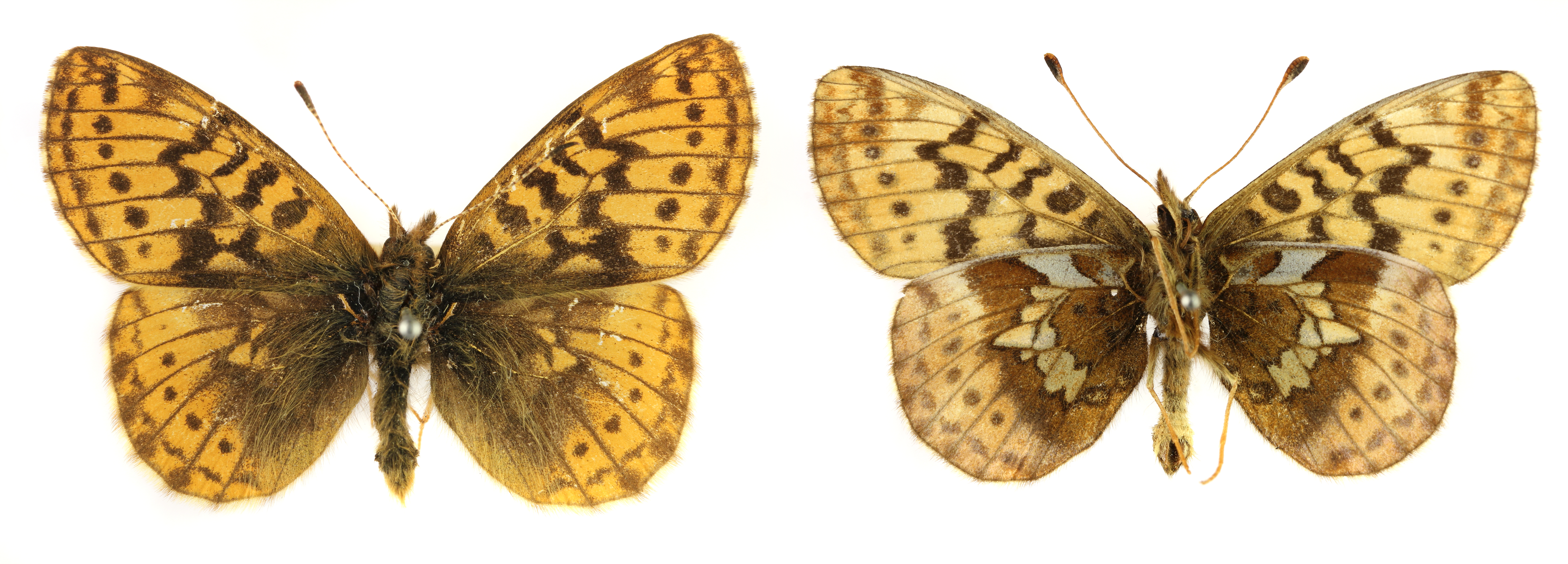Boloria Frigga on:
[Wikipedia]
[Google]
[Amazon]
''Boloria frigga'', the Frigga fritillary, is a
 Seitz ''A. frigga'' Thnbg. (68e). Above pale reddish yellow, the black markings in the central and marginal areas very straight, being parallel with the distal margin. The under surface is very characteristic on account of the broad cinnamon margin of the forewing and the but little variegated hindwing, only the paler distal margin of the latter somewhat contrasting with the cinnamon basal area. The median band, like the ground dusted with cinnamon, is but slightly prominent, only an irregularly rhomboidal pale spot before the middle of the costa being conspicuous. Its habitats include willow and sphagnum bogs.
Seitz ''A. frigga'' Thnbg. (68e). Above pale reddish yellow, the black markings in the central and marginal areas very straight, being parallel with the distal margin. The under surface is very characteristic on account of the broad cinnamon margin of the forewing and the but little variegated hindwing, only the paler distal margin of the latter somewhat contrasting with the cinnamon basal area. The median band, like the ground dusted with cinnamon, is but slightly prominent, only an irregularly rhomboidal pale spot before the middle of the costa being conspicuous. Its habitats include willow and sphagnum bogs.
butterfly
Butterflies are insects in the macrolepidopteran clade Rhopalocera from the Order (biology), order Lepidoptera, which also includes moths. Adult butterflies have large, often brightly coloured wings, and conspicuous, fluttering flight. The ...
of the family Nymphalidae
The Nymphalidae are the largest family of butterflies, with more than 6,000 species distributed throughout most of the world. Belonging to the superfamily Papilionoidea, they are usually medium-sized to large butterflies. Most species have a red ...
with a circumboreal
The Circumboreal Region in phytogeography is a floristic region within the Holarctic Kingdom in Eurasia and North America, as delineated by such geobotanists as Josias Braun-Blanquet and Armen Takhtajan.
It is the largest floristic region in t ...
distribution. It occurs in bog
A bog or bogland is a wetland that accumulates peat as a deposit of dead plant materials often mosses, typically sphagnum moss. It is one of the four main types of wetlands. Other names for bogs include mire, mosses, quagmire, and muskeg; a ...
s and tundra
In physical geography, tundra () is a type of biome where tree growth is hindered by frigid temperatures and short growing seasons. The term ''tundra'' comes through Russian (') from the Kildin Sámi word (') meaning "uplands", "treeless moun ...
in Northern Europe
The northern region of Europe has several definitions. A restrictive definition may describe Northern Europe as being roughly north of the southern coast of the Baltic Sea, which is about 54th parallel north, 54°N, or may be based on other g ...
to the north of 60° N, very locally in more southern locations, as well as in the Urals
The Ural Mountains ( ; rus, Ура́льские го́ры, r=Uralskiye gory, p=ʊˈralʲskʲɪjə ˈɡorɨ; ba, Урал тауҙары) or simply the Urals, are a mountain range that runs approximately from north to south through European ...
, Siberia
Siberia ( ; rus, Сибирь, r=Sibir', p=sʲɪˈbʲirʲ, a=Ru-Сибирь.ogg) is an extensive geographical region, constituting all of North Asia, from the Ural Mountains in the west to the Pacific Ocean in the east. It has been a part of ...
, Northern Mongolia
Mongolia; Mongolian script: , , ; lit. "Mongol Nation" or "State of Mongolia" () is a landlocked country in East Asia, bordered by Russia to the north and China to the south. It covers an area of , with a population of just 3.3 million, ...
, the Russian Far East
The Russian Far East (russian: Дальний Восток России, r=Dal'niy Vostok Rossii, p=ˈdalʲnʲɪj vɐˈstok rɐˈsʲiɪ) is a region in Northeast Asia. It is the easternmost part of Russia and the Asian continent; and is admini ...
, western parts of the United States and Canada
Canada is a country in North America. Its ten provinces and three territories extend from the Atlantic Ocean to the Pacific Ocean and northward into the Arctic Ocean, covering over , making it the world's second-largest country by tot ...
.Львовский А.Л., Моргун Д.В. 2007. Булавоусые чешуекрылые Восточной Европы. Москва: КМК. . p. 324.Tolman, Tom & Richard Lewington. 1997. ''Butterflies of Britain and Europe. Field Guide.'' London: Collins. .
Description
Biology
Larvae feed on ''Rubus chamaemorus
''Rubus chamaemorus'' is a species of flowering plant in the rose family Rosaceae, native to cool temperate regions, alpine and arctic tundra and boreal forest. This herbaceous perennial produces amber-colored edible fruit similar to the blackbe ...
'', ''Vaccinium oxycoccos
''Vaccinium oxycoccos'' is a species of flowering plant in the heath family. It is known as small cranberry, marshberry, bog cranberry, swamp cranberry, or, particularly in Britain, just cranberry. It is widespread throughout the cool temperate ...
'' and occasionally on ''Vaccinium uliginosum
''Vaccinium uliginosum'' (bog bilberry, bog blueberry, northern bilberry or western blueberry) is a Eurasian and North American flowering plant in the genus ''Vaccinium'' within the heath family.
Distribution
''Vaccinium uliginosum'' is native ...
''. In experimentation they accept ''Polygonum viviparum
''Bistorta vivipara'' ( synonym ''Persicaria vivipara'') is a perennial herbaceous flowering plant in the knotweed and buckwheat family Polygonaceae, commonly known as alpine bistort. Scientific synonyms include ''Bistorta vivipara'' and ''Polygo ...
'' and ''Rubus fruticosus
''Rubus fruticosus'' L. is the ambiguous name of a European blackberry species in the genus ''Rubus'' in the rose family. The name has been interpreted in several ways:
*The species represented by the type specimen of ''Rubus fruticosus'' L., ...
''. The species produces one generation every two years.
References